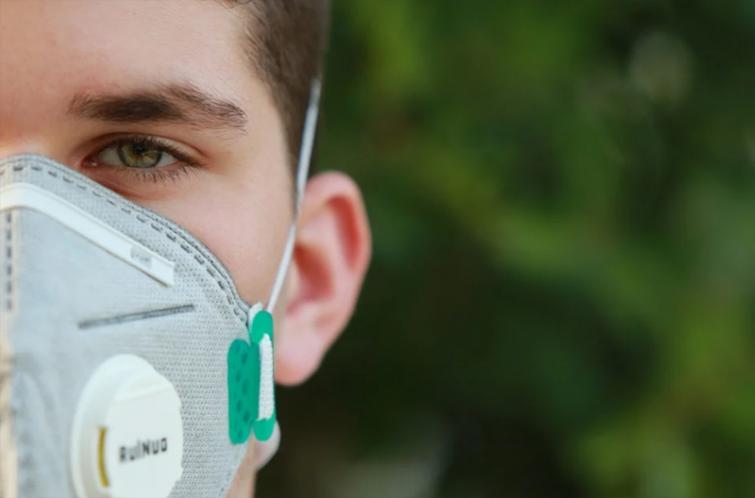
Widespread facemask use could prevent a second COVID-19 wave, says study
London/IBNS: Even basic homemade masks can significantly reduce transmission if enough people wear them when in public, according to latest modelling. Researchers call for information campaigns that encourage the making and wearing of facemasks.
Population-wide use of facemasks keeps the coronavirus ‘reproduction number’ under 1.0, and prevents further waves of the virus when combined with lockdowns, a modelling study led by the University of Cambridge suggests.
The research suggests that lockdowns alone will not stop the resurgence of SARS-CoV-2, and that even homemade masks with limited effectiveness can dramatically reduce transmission rates if worn by enough people, regardless of whether they show symptoms.
The researchers call for information campaigns across wealthy and developing nations alike that appeal to our altruistic side: 'my facemask protects you, your facemask protects me'. The findings are published in the Proceedings of the Royal Society A.
“Our analyses support the immediate and universal adoption of facemasks by the public,” said lead author Dr Richard Stutt, part of a team that usually models the spread of crop diseases at Cambridge’s Department of Plant Sciences.
“If widespread facemask use by the public is combined with physical distancing and some lockdown, it may offer an acceptable way of managing the pandemic and reopening economic activity long before there is a working vaccine.”
Dr Renata Retkute, coauthor and Cambridge team member, said: “The UK government can help by issuing clear instructions on how to make and safely use homemade masks.”
“We have little to lose from the widespread adoption of facemasks, but the gains could be significant.”
The new coronavirus is transmitted through airborne droplets loaded with SARS-CoV-2 particles that get exhaled by infectious people, particularly when talking, coughing or sneezing.
For the latest study, Cambridge researchers worked to link the dynamics of spread between individuals with population-level models, to assess different scenarios of facemask adoption combined with periods of lockdown.
The modelling included stages of infection and transmission via surfaces as well as air. Researchers also considered negative aspects of mask use, such as increased face touching.
The reproduction or ‘R’ number – the number of people an infected individual passes the virus onto – needs to stay below 1.0 for the pandemic to slow.
The study found that if people wear masks whenever they are in public it is twice as effective at reducing ‘R’ than if masks are only worn after symptoms appear.
In all modelling scenarios, routine facemask use by 50% or more of the population reduced COVID-19 spread to an R less than 1.0, flattening future disease waves and allowing less-stringent lockdowns.
Viral spread reduced further as more people adopted masks when in public. 100% mask adoption combined with on/off lockdowns prevented any further disease resurgence for the 18 months required for a possible vaccine.
The models suggest that – while the sooner the better – a policy of total facemask adoption can still prevent a second wave even if it isn’t instigated until 120 days after an epidemic begins (defined as the first 100 cases).
The team investigated the varying effectiveness of facemasks. Previous research shows that even homemade masks made from cotton t-shirts or dishcloths can prove 90% effective at preventing transmission.
The study suggests that an entire population wearing masks of just 75% effectiveness can bring a very high ‘R’ number of 4.0 (the UK was close to this before lockdown) all the way down to under 1.0, even without aid of lockdowns.
In fact, masks that only capture a mere 50% of exhaled droplets would still provide a 'population-level benefit', even if they quadrupled the wearer’s own contamination risk through frequent face touching and mask adjustment – a highly unlikely scenario.
The researchers point out that crude homemade masks primarily reduce disease spread by catching the wearer’s own virus particles, breathed directly into fabric, whereas inhaled air is often sucked in around the exposed sides of the mask.
“There is a common perception that wearing a facemask means you consider others a danger,” said Professor John Colvin, coauthor from the University of Greenwich. “In fact, by wearing a mask you are primarily protecting others from yourself.”
“Cultural and even political issues may stop people wearing facemasks, so the message needs to be clear: my mask protects you, your mask protects me.”
“In the UK, the approach to facemasks should go further than just public transport. The most effective way to restart daily life is to encourage everyone to wear some kind of mask whenever they are in public,” Colvin said.
Professor Chris Gilligan, coauthor from Cambridge’s Epidemiology and Modelling Group in the Department of Plant Sciences, added: “These messages will be vital if the disease takes hold in the developing world, where large numbers of people are resource poor, but homemade masks are a cheap and effective technology.”
Support Our Journalism
We cannot do without you.. your contribution supports unbiased journalism
IBNS is not driven by any ism- not wokeism, not racism, not skewed secularism, not hyper right-wing or left liberal ideals, nor by any hardline religious beliefs or hyper nationalism. We want to serve you good old objective news, as they are. We do not judge or preach. We let people decide for themselves. We only try to present factual and well-sourced news.







